US Military deploys airships to protect US cities from cruise missile threats
New airships are part of a new early warning detection system against threats
PUBLISHED : Thursday, 18 December, 2014, 9:58pm
UPDATED : Thursday, 18 December, 2014, 9:58pm
Associated Press in Middle River, United States

US personnel inflated the aerostat with helium.
The US Army has showed off an airship that is designed to help the military detect and destroy cruise missiles speeding toward the nation's capital or other major east coast cities.
The radar-toting vehicle will be launched next week as part of a three-year test of the system at Aberdeen Proving Ground, northeast of Baltimore.
When fully deployed next spring, the system will feature two, unmanned, helium-filled aerostats, tethered to concrete pads 6.5 km apart. They'll float at an altitude of 3,000 metres, about one-third as high as a commercial airliner's cruising altitude.
One balloon will continuously scan in a circle from upstate New York to North Carolina's Outer Banks, and as far west as central Ohio. The other will carry precision radar to help the military on the ground to pinpoint targets.
The aerostats won't carry weapons, military officials said. Enemy missiles would be destroyed by air, ground or ship-based weapons.
The system is called JLENS, short for Joint Land Attack Cruise Missile Defence Elevated Netted Sensor System.
"We can defeat cruise missiles but we have limited capability to detect. And so, with an elevated sensor, such as JLENS, and the ability to look out over the horizon, now we have the ability to detect and to enable our systems to defeat cruise missiles," said Major General Glen Bramhall, commander of the 263rd Army Air and Missile Defence.
The project, built by Raytheon of Waltham, Massachusetts, and TCOM L.P. of Columbia, Maryland, has cost the US government about US$2.8 billion so far. Congress approved another US$43.3 million last week for the first year of the test.
Proponents say JLENS will save money in the long run by reducing the need for surveillance by conventional aircraft.
"The analysis we've done says it's about five to seven times less than operating a fleet of aircraft to cover the same area over the same time period," said Douglas Burgess, Raytheon's JLENS programme director.
The white balloons that were displayed on Wednesday are each 73 metres long and are part of a new wave of lighter-than-air surveillance equipment. The US government also has deployed tethered airships near the Mexican border, in Iraq and Afghanistan and in the Caribbean to combat drug smuggling.
The airships at Aberdeen will be the first of their type near a major east coast city.
The military said the balloons won't carry cameras but David Rocah of the American Civil Liberties Union in Maryland said privacy advocates were leery of the airships' ability to constantly monitor moving objects, including cars on the ground.
Bramhall said the radar can't identify individuals or record cellphone conversations.
"The mission is not to spy on US citizens. It is not designed for that," he said.
